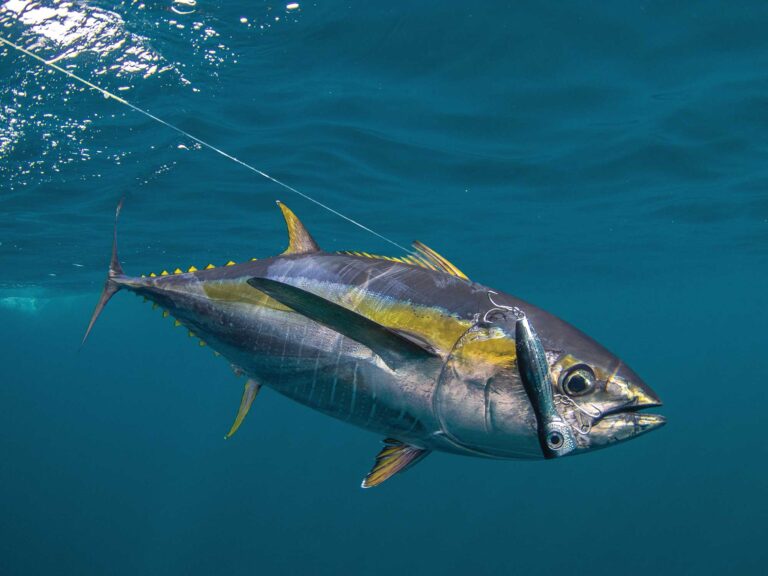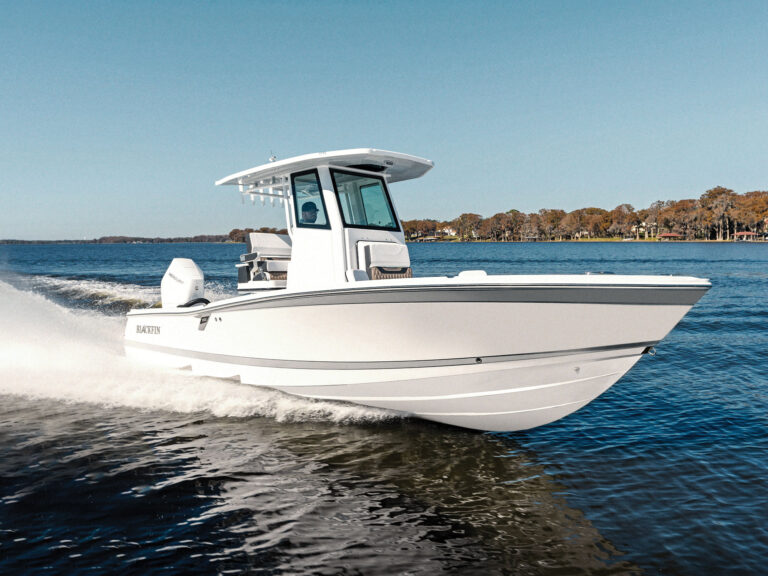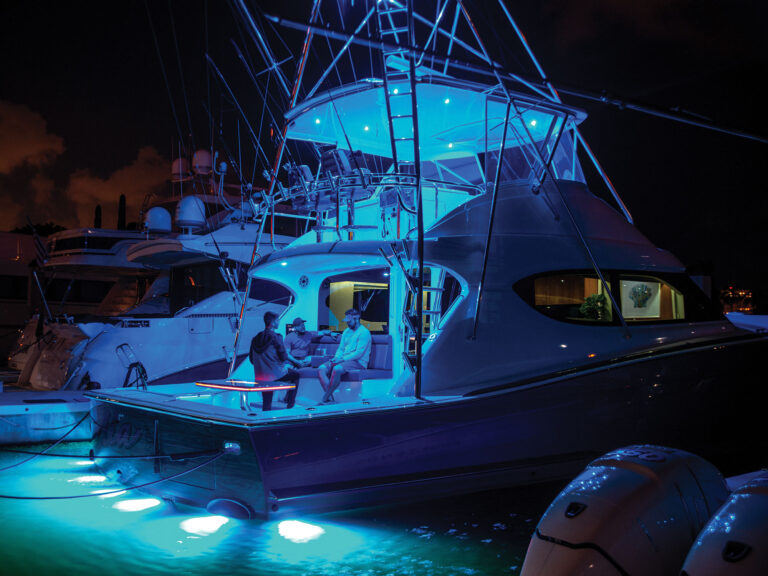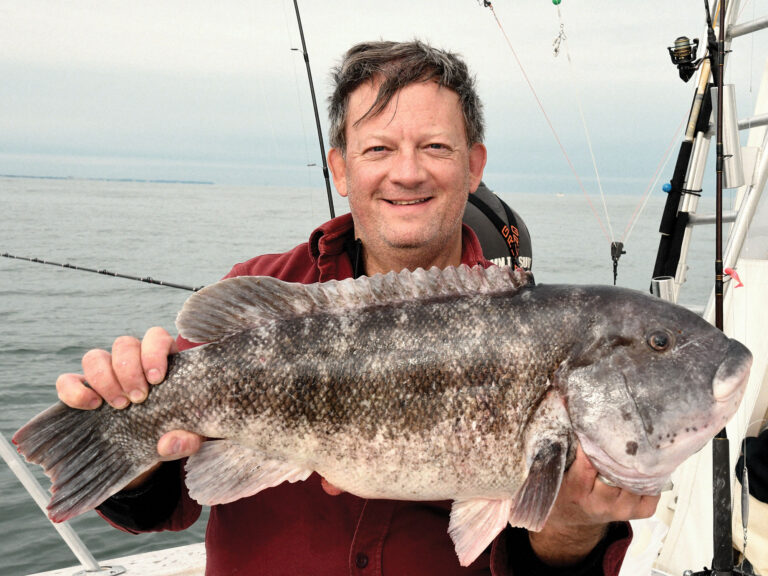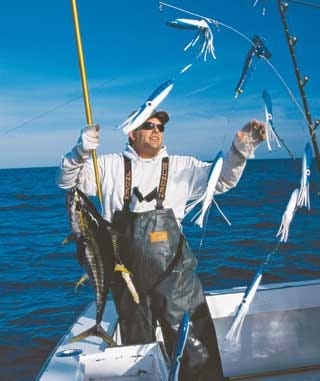
|| |—| || |Mate Joel Weir swings another tuna aboard the Fintastic. The yellowfin was fooled by a spreader bar pulling plastic squid and a bird. | Even though I had on three layers of clothes, I was still cold. Huddled in the cockpit of Captain Dick Harris’ 53-foot, Carolina-built charterboat, Fintastic, I watched Oregon Inlet disappear into the horizon as we barreled offshore. This didn’t feel much like tuna fishing weather to me, but Harris was betting that the yellowfin would be snapping and he had the cards stacked in his favor.
The night before, Harris had been checking satellite images of ocean water temperatures and noticed that an eddy of 70-degree water had broken off the Gulf Stream and moved to an area known as the Point. He was sure that the eddy would hold yellowfin tuna. Trusting Harris’ 30 years of experience fishing off the Outer Banks, the crew was sure he would be right.
After a 90-minute run, Harris dropped the throttles to trolling speed and mate Joel Weir chucked the baits overboard. A steady northerly breeze ruffled the blue-green sea. Harris’ water temperature gauge bounced between 68 and 70 degrees – perfect conditions for tuna fishing. As soon as the baits were set, the left flatline clip snapped open and the rod in the left corner of the cockpit bent under the pull of a nice fish. The party was still waking up and stumbling around in the cabin when Weir announced, “Fish on! Who’s up first?” With that, the other flatline snapped and the right rigger clip popped open. “I need two more anglers!” Weir yelled into the cabin. A triple hookup. Captain Harris was right – the tuna were on the Point.
WHAT’S THE POINT?
The Point is one of the Mid-Atlantic’s most famous fishing grounds because it is easy to reach and consistently holds fish.
The area gets its name from the box canyon that juts into the Continental Shelf about 36 miles southeast of Oregon Inlet. At the Point, the water depth plummets from 30 fathoms to 400 fathoms within a square mile. The Gulf Stream feeds the canyon a steady supply of grass, bait and gamefish. When fish traveling on the Stream reach the Point, they stop and hang out for a while, like tourists enjoying the scenery and taking a break from life in the fast lane.
There are three keys to finding fish at the Point, according to Harris. They are temperature, water clarity and bait. The first thing he looks for is water temperature above 66 degrees. Early in the season when other anglers aren’t thinking tuna, a warm pool of water that blows in from the Gulf Stream will bring fish with it. This is the best time to fish the Point, when the crowds are gone but the fish are there.
“Water color is not as important as clarity,” he says. Clear green water will hold fish as well as clear blue water. Of course, if the bait is there the fish will not be far behind. Different seasons bring different baitfish. In the winter and early spring, the tuna are feeding on squid. As the year progresses, flying fish move in and bigger tuna follow them. Harris matches his lures to the bait that is present, pulling chain squid and spreader bars to mimic schools of squid.
For anglers fishing the Point, a southeasterly wind is bittersweet. Although it produces the roughest weather, it also pushes warm water and fish inshore. A northerly wind tends to blend the water together while a southwesterly will stack the warm water up resulting in a hard current edge between dirty green and clear blue water. The ideal weather scenario would be several days of southeast wind followed by a switch to the north.
Those are exactly the conditions we found upon our arrival to the Point, and the fish were there with a vengeance to prove Harris’ theory.
FISHING THE POINT
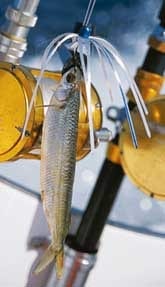
| |Ballyhoo and Seawitches make up the brunt of Captain Dick Harris’ yellowfin arsenal. He prefers bright skirts on bright days opting for more white than blue when the sun is out. | The day we fished, the sea was calm and appeared deserted. On other trips, I’ve seen the Point boiling with life, birds diving, fish pushing water, flying fish sailing across the waves and grass and temperature breaks crisscrossing the area. We had no such sign this day, but the sea was warm and clear and Harris was hooking one tuna after another.
These are the days that separate the “Pros” from the “Ams.” Harris had our crew constantly cranking on fish while the small private boats that had followed us out were trolling – and trolling without much action.
The party was working in another doubleheader when a couple of center consoles ran slow circles around the Fintastic. “Why aren’t the other boats catching?” I asked Harris.
“Could be a lot of things,” he said, “maybe it’s their baits or maybe it’s their trolling pattern.”
He pointed to a huge Nav Net chartplotter he had on his console.
“We’re running along the edges of these drops and through the valleys,” he explained running his fingers parallel to the depth contours on the chart, “the outboard guys are all over the place.”
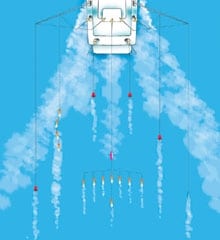
| |At the Point, captains pull a combination of skirts and ballyhoo then throw in a squid chain or spreader bar to make some noise. Here’s a typical spread: skirted ballyhoo or cedar plugs should be pulled on flatlines directly behind the boat (A). A skirted ballyhoo or a squid chain is trolled on each short rigger line (B), dangling in the water past the flatlines. Ballyhoo, one skirted (C) /one naked (D) occupies each line running from the long riggers. Down the middle, captains can run a naked ballyhoo or a spreader bar (E) just beyond the long rigger baits. Trolling speed and the lure distance from the boat depend on variables including wind speed, current, sea height, and boat performance.| Looking out over the ocean, where the untrained eye only sees an endless expanse of open water, Harris sees the bottom structure that lies hundreds of feet below. He pointed to a purple charterboat that had come to a stop, with an angler fighting a fish in the cockpit.
“Hank’s on a drop in 120 fathoms of water,” Harris said, “But while we’ve been fighting these fish we’ve drifted off into 30 fathoms.”
When the smaller boats saw that we were hooked up, they would rush over and troll around us. Sometimes, they would come right up in our drifting baits.
“What they don’t realize,” Harris said, “is that we’re not where the fish are.” On days when the tuna are thick, anyone can drop a bait in the water and hook up. When the fish are spread out, it takes strategy and good electronics to find the tuna.
Harris first finds the warm water then he starts looking for the structure. He trolls along the canyon edges, works the deeper valleys or moves off to fish a plateau called the Meadow.
As we were trolling an edge between 90 and 120 fathoms, one of the flatlines popped and the reel began to sing. The captain kept trolling and the left short rigger went down followed by the right long rigger. Harris took the boat out of gear and three anglers began working in their tuna. As I stood on the flybridge watching the party joke and laugh while fighting tenacious yellowfin, the right long line popped and the reel next to me jumped and bounced in the rod holder, nearly scaring me out of my skin. We had hooked a fourth fish while drifting!
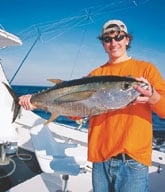
| |Amid almost constant action, Jason Buckley pauses to show off his catch.| Once Weir had the fish in the box and the lines reset, Harris moved off down the structure in the hope of finding another pod of tuna while letting the school we had just pulled from regroup and come back to the surface.
Just then, the VHF radio began to squawk: “Anyone catching any tuna at the Point?”
The Captain laughed and picked up the transmitter. Holding his nose and speaking in a high-pitch nasally voice he responded, “The Point, yeah the Point!”
The radio whined with a noticeably northern accent, “We’re running up from Hatteras Inlet and want to know if anyone at the Point has seen any tuna.”
Harris responded in his falsetto, “I’ve seen tuna,” giggling after he released the call button.
“Can we get some numbers, Captain?” the radio begged.
“Numbers?” Harris mocked.
“Numbers for the tuna.” The guy on the radio was getting frustrated.
Harris chuckled and took his hand off his nose. In his friendly Outer Banks draw he responded, “Come up to (he gave the guy the numbers) and you’ll find some fish, Captain.”
“Thanks Captain,” the voice on the radio came back, relieved, “we’ll see you in a few minutes.”
Harris couldn’t stop chuckling.
THE SPREAD
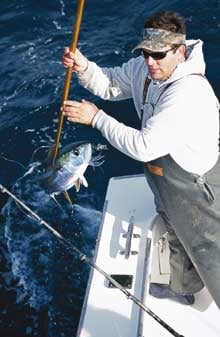
| |The use of crank-on leaders allows anglers to work fish right to the boat which makes gaffing much easier.| Harris’ trolling spread is time-tested and effective. Sea-witch skirts and ballyhoo make up the bulk of his tuna arsenal. They typically run a nine-rod spread with two flatlines off the stern pulling seawitches; two short riggers, one with a sea witch and one with a squid chain and two, long riggers each sporting a skirted ballyhoo. From the flybridge, Harris fishes two shotguns pulling rigged ballyhoo, one naked and one dressed, and a spreader bar.
Harris and Weir tie their own skirts, coming up with wild color combinations that they’ve given wild names such as: Green Lantern, White Night and Supreme. They have made a study of water and weather, carefully matching the skirt colors to the conditions.
The day that I fished on the Fintastic, it was bright and sunny and the water was fairly clear. Joel employed white-and-blue skirts favoring lures that had more white hair than blue. On overcast days, he uses darker skirts. When the water is green, they use pink.
“The key is to mix up the spread,” Weir said as he dropped back a black-and-maroon-skirted ballyhoo. Even though the dark-colored bait went against their bright-bait-on-bright-day rule, fish don’t always follow the rules. He rigs his ballyhoo on 9/0 hooks with a 3¿¿4-ounce egg sinker wired to it.
Weir has also gone to using crank-on leaders. All his “skirt” rods are rigged with 100-pound-test, barrel swivels that can be cranked through the line guides and directly onto the reel. This allows the angler to reel in the 50 feet of 100-pound test Ande leader, eliminating the need for him to handline a fish to the boat. When several fish were hooked at once, Weir was able to move freely about the deck, gaffing tuna and dumping them into the box one after another.
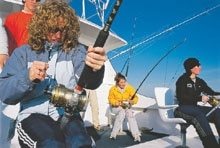
| |A yellowfin double: two anglers battle fish that were hooked in 120 fathoms of water.| Once the sun was well overhead, the wind quit blowing and the sea glassed over. Weir disappeared into the cabin and returned with a spreader bar rigged with a homemade bird in front of 10 blue-and-white squid trailed by a single white squid armed with a banghook. When he dropped the rig back 75 yards and set the reel in gear, the spreader bar banged and crashed on the surface shooting spray in every direction.
The commotion got the tunas’ attention – within minutes, a big swirl opened behind the bar and the contraption disappeared under the surface. Then two other lines went down and Weir went into the cabin looking for anglers to crank in fish.
When Harris marks deep bait on the fishfinder but can’t get a bite on the surface, he drops down a planer or downrigger. After he hooks a tuna others often follow to the surface.
By noon the wind was calm, the sun was burning down, and we had a limit of yellowfin in the fishbox. The warm temperatures had us peeling off our jackets, gloves, and watch caps, fishing in shirts and jeans. Now this felt like tuna weather!
| Finding the Water For many fishermen, each day starts with a visit to the satellite water temperature website to find the warm water that holds the fish. Offshore anglers check the [Rutgers website](http://marine.rutgers.edu/mrs/sat_data/?product=sst ¿humbs=0) as often as other people check their email. NOAA maintains the satellite and the site is provided by the Institute of Marine and Coastal Science at Rutgers University. The image is updated at least nine times a day. Sea Surface temperatures can be obtained from the Rutgers site for a variety of East Coast areas. The gray area on the image (right) is land and the 100-fathom drop is outlined in black. The position of land and bathometric lines is approximate. Use the color key at the right to find the temperature of the water. White areas are clouds. Bright purple may also be thin cloud cover that caused the computer to register cold water. On image (right), check out the blob of red orange that appears just off Oregon Inlet. That is an eddy of water that held a limit of tuna for the party aboard the Fintastic. Be sure to consult the website before you go. |

Water temperature is the key to finding tuna at the Point. Here’s the satellite image for the day the author fished with Capt. Harris. Note the plume of warm water off Hatteras.|
| IF YOU GO SEASONS OF THE POINT – To find the Point, set the compass for 125 degrees and run for 36 miles or set the Loran to 26 795 and 40 580. Anglers chasing tuna will need to obtain a Highly Migratory Species permit before leaving the dock. The permit is available on line at www.nmfspermits.com or by phone at (888) 872-8862. Currently, each angler may keep three yellowfin tuna, larger than 27 inches, per day. To fish the Point with Captain Harris, contact him through Oregon Inlet Fishing Center (see below). OREGON INLET LAUNCH RAMPS National Park Service Boat Ramp: Oregon Inlet Fishing Center off Highway 12. Washington Baum Bridge Boat Ramp: Off Highway 64 Across from Pirates Cove Marina.OUTFITTERS Oregon Inlet Fishing Center: (800) 272-5199 TW’s Bait and Tackle: www.twstackle.com, (252) 453-3339 TI’s Bait and Tackle: www.tistackle.com, (252) 441-3166 Whalebone Tackle: (252) 441-7413MARINAS AND CHARTER FISHING CENTERS Pirate’s Cove Marina: www.fishpiratescove.com, (800) 367-4728 Oregon Inlet Fishing Center: www.oregon-inlet.com, (800) 272-5199HATTERAS INLET LAUNCH RAMPS Teach’s Lair: www.teachslair.com (888) 868-2460 ¿ (252) 986-2460 Village Marina: www.villagemarinahatteras.com, (252) 986-2522 Hatteras Harbor: www.hatterasharbor.com, (800) 676-4939OUTFITTERS Frisco Cove Marina: (252) 995-4242; www.friscocove.com Frisco Rod and Gun: www.friscorodandgun.com, (252) 995-5366 Red Drum Tackle: www.reddrumtackle.com, (252) 995-5414MARINAS AND CHARTER FISHING CENTERS Oden’s Dock: www.odensdock.com, (888) 544-8115 Teach’s Lair: www.teachslair.com, (888) 868-2460 Village Marina: www.villagemarinahatteras.com, (252) 986-2522 Hatteras Harbor: www.hatterasharbor.com, (800) 676.4939 Hatteras Landing: www.hatteraslanding.com, (800) 551-8478 |





